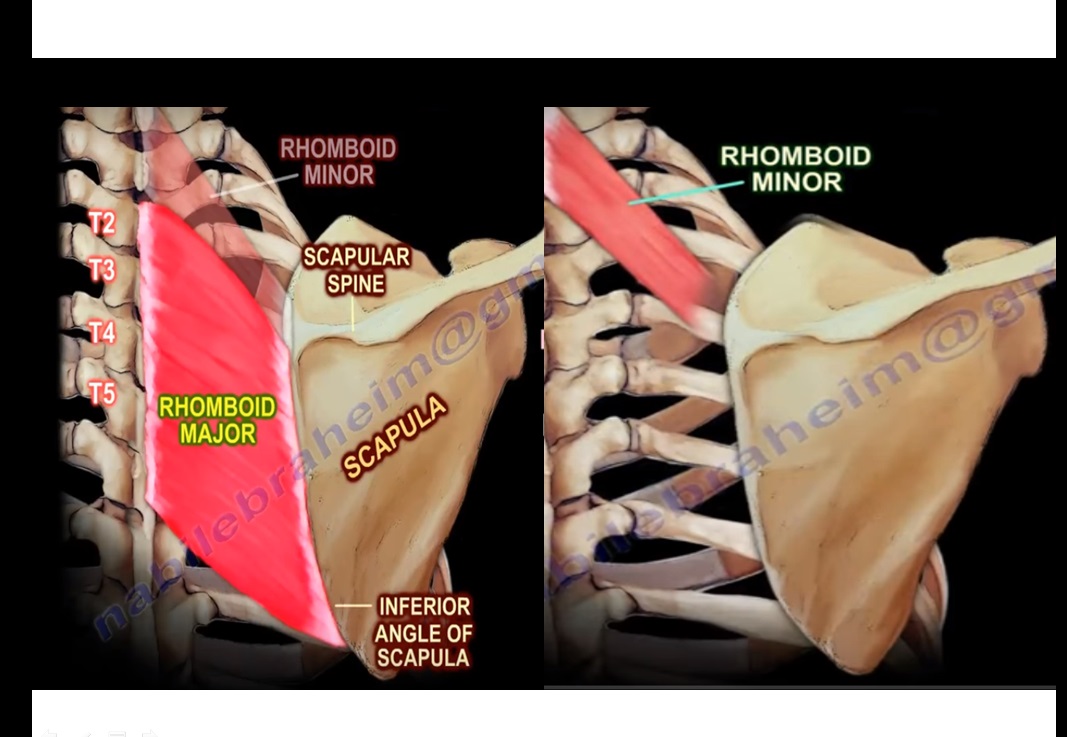Courtesy: Prof Nabil Ebraheim, University of Toledo, Ohio, USA
ANATOMY, FUNCTION AND DYSFUNCTION OF RHOMBOID MUSCLES
- Rhomboid muscles are rhombus shaped muscles that lie underneath the trapezius muscle
- They connect scapula to the vertebrae and thus holds it close to the thoracic wall
- It is shaped like a diamond or kite, i.e a rhombus and hence the name
- There are 2 rhomboid muscles, on each side of the upper back
1.Rhomboid major
ORIGIN: spinous process from T2 to T5
INSERTION:Medial or vertebral border of scapula from the level of scapular spine to the inferior angle of scapula
2.Rhomboid minor
ORIGIN:Nuchal ligament of spinous process of C7 and T1
INSERTION: Medial border of scapula above the insertion of rhomboid major
NERVE SUPPLY
Dorsal scapular nerve- (C4, C5)
ACTIONS
1. Adduct and retract scapula by pulling it towards the vertebral coloumn
2. Work with the levator scapulae to elevate the medial border of scapula
3. Rotate scapula downwards with respect to glenohumeral joint
4. Helps in proper movement and stability of scapula and thus play a crucial role in maintaining shoulder function
Brachial plexus injury
- In postganglionic injury the functions of serratus anterior and the rhomboids will be preserved, carries a better prognosis
- In preganglionic injury or root avulsion both serratus anterior and rhoimboids will be affected and is also associated with Horner’s syndrome(ptosis, miosis and anhidrosis) due to disruption of sympathetic chain
Winging of scapula-the medial border of scapula moves more medially due to loss of serratus anterior and rhomboids function
Rhomboid trigger points
- Manifests as superficial pain between the shoulder blades
- Pain will be more closer to the scapula than the spine
- Pain occurs at rest and is not influenced by movements
- If grinding/snapping/ crunching noise occurs while moving scapula then scapulothoracic impingement or snapping scapula should be ruled out
- Other muscle trigger points can also be associated with, like levator scapulae or trapezius
Aggravating factors
1.Painters holding arms above head for a long time
2.Bad posture
3.Habitually working in a protracted position- i.e, computer related desk job, sewing or reading.
In this case the pectoralis muscles may become shortened and over active and rhomboids become stretched due to counteraction
So it is better to stretch out pectoralis first, because if we try to stretch a rhomboid with tight pectoralis it may increase the weakness and irritation of rhomboid trigger points
Treatment
1.Anti inflammatory drugs
2.Stretching out pectoralis muscle
3.Rhomboid trigger point release
A massage ball is the tool to go for massaging rhomboid muscles.
Place it between your shoulder blade and your spine.Then push it against a wall.Now start to roll with the ball over the areas of pain.When you encounter a tender spot, work it a couple of times with slow and precise strokes
4.Possible injection of trigger points

Leave a Reply